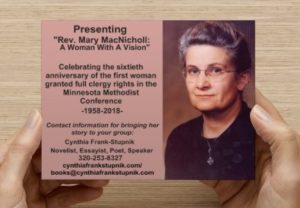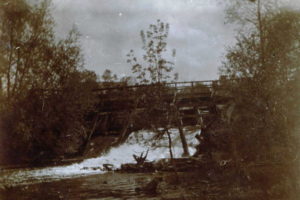
United Methodist Church
“Where Two Rivers Meet”: Book Launch

I am pleased to invite you to the launch of “Where Two Rivers Meet” on Sunday afternoon, January 14th, at 1 p.m. We will meet at the United Methodist Church in Clearwater, Minnesota. Come join us for a little music, and a little talk about Clearwater history, Minnesota Main Street Women, especially, the protagonist of the new novel, the first woman of Clearwater, Abigail Camp Porter. We will share some prizes, a chance to see all my books, and of course, an opportunity to share a piece of cake.
Following the parade path
Today, two WCCO news guys, Matt Brinkman and Jason DeRusha, reported from Lake Minnetonka on the segment “Goin’ to the Lake.” They talked a bit about the lake’s beauty, the great food outlets along the shore, and supplied a short history of the area. I was a bit dismayed when they started with Prince–even non-cult followers like me know “Purple Rain.” They gave the audience a Wikipedia-like summary of its early history, mentioning early “settlers.” I know this is history, Minnesota’s history, and I know they don’t have lots of time to say everything on air, so I get it.

Of course, Native Americans were the first to settle here–dating back thousands of years. They treasured and honored the vast hunting grounds and this huge crystal-clear lake for the sustenance it provided. I doubt they would have dealt with lake disease like e-coli. Yet, and who and what the newscasters didn’t mention was Clearwater, Minnesota’s future founder Simon Stevens, brother to the “Father of Minneapolis,” John Harrington Stevens, who owned land in and around Clearwater as well, both of whom I write about in my historical Around Clearwater. Simon and Calvin Tuttle were two of the first white men to explore and settle this area. They followed what is now called Minnehaha Creek west until they found this huge body of water Native Americans had told about. Once here, they built a sawmill, thus beginning the initial settlement; “Minnetonka has a long history stretching back to the mid-1800s when the first settlement was established along Minnehaha Creek.”
Little has been written about Simon or connect him to this site, very few people connect him to brother John Harrington Stevens, and few know he was such a historic character who made so much happen in Minnesota. Without him and others like him, Clearwater might not have been founded. This weekend, Friday, in particular, Clearwater celebrates its heritage, and like days of old, the town sponsors a kiddie parade. After a long postponement, both the kiddie and the grown-up parade are back, where I think it belongs because of the word HERITAGE, downtown Main Street, where the town first began running parallel to the Clearwater and Mississippi Rivers. So here is a brief identification and synopsis of the parade route. Follow the Grand Marshal, Elaine Paumen, and take notice of the town that used to be. (By the way, you can gather more information about the sites in my AROUND CLEARWATER historical.)
- Start at the Clearwater Dam area.
Where the Rendezvous will be setup is where Clear Water–began. Sawmills, Quinn’s Tasting Room (not a saloon but it old booze),pulp mills, flour mills, and a number of other stores lined the banks of the Clearwater River. Abigail Camp Porter became the first white woman to settle in the village. She came from Stowe, Vermont, and served as the housekeeper for the first townsite hotel–along the banks of the river. BTW, none of this was there anymore even when I was a youngster.
- As you come to the top of a slight rise, you’ll come to a newer section of town, as far back as the 1860s or so–Here on Oak Street, after you were dropped off by the ferry on the banks of the Mississippi,
 you’d most likely find a few buildings to inspect. Hardware stores, watch and jewelry dealers, general mercantile, shoes–you name it, and you could find it here.
you’d most likely find a few buildings to inspect. Hardware stores, watch and jewelry dealers, general mercantile, shoes–you name it, and you could find it here.
 Boutwell’s Hardware Store sat on the corner, a few hundred feet from the ferry landing. Upstairs, Maude Porter had her millinery store, as I wrote about in Pins & Needles. Across the street sat Pat Quinn’s Saloon and the Whiting Building–none of these buildings are there anymore.
Boutwell’s Hardware Store sat on the corner, a few hundred feet from the ferry landing. Upstairs, Maude Porter had her millinery store, as I wrote about in Pins & Needles. Across the street sat Pat Quinn’s Saloon and the Whiting Building–none of these buildings are there anymore. 
To the west is the Masonic Temple–still standing– that houses the Masons upstairs, and hosted a variety of different businesses –general mercantile, beer parlors etc. 
Jessie Maude Porter’s last home sat next to Solingers but that too is gone.  She was daughter to T. C. Porter and Abigial Camp Porter, early towns founders. Maude lived to be 103, was born, and lived all but her last year or so in Clearwater.
She was daughter to T. C. Porter and Abigial Camp Porter, early towns founders. Maude lived to be 103, was born, and lived all but her last year or so in Clearwater.
Kitty-corner is the United Methodist Church on Elm.  This was the first church that was formed, but the first church built was the Congregationalist and sits on the hill by the apartment-once-school building.
This was the first church that was formed, but the first church built was the Congregationalist and sits on the hill by the apartment-once-school building.
A building or two down is another hardware store that is now owned by potters. When I was young, we often went here to buy nails, a stash of gifts, and just about everything else. And next to that is now a business office but it was once a bank as well.
Across from here at an angle are an old home and meat market, once owned by Luther Laughton–a name very well-known to the early citizens.

3. I am beginning  here with #3 because this building which now houses apartments was the Phillip Drug Store that I write about in Scruples & Drams http://www.cynthiafrankstupnik.com/product/scruples-drams-novel-minnesotas-main-street-women/. On the corner of Maple, this historic building has lived many lives. Drug store, Kniss Grocery, and now apartments to say the least. Right next door was –not so historic–Tri-County Lumber. Directly across the street from Phillips’s stood a hotel that burned down and was replaced by another grocery store, and then variety store.
here with #3 because this building which now houses apartments was the Phillip Drug Store that I write about in Scruples & Drams http://www.cynthiafrankstupnik.com/product/scruples-drams-novel-minnesotas-main-street-women/. On the corner of Maple, this historic building has lived many lives. Drug store, Kniss Grocery, and now apartments to say the least. Right next door was –not so historic–Tri-County Lumber. Directly across the street from Phillips’s stood a hotel that burned down and was replaced by another grocery store, and then variety store.
4. Nearly at the Next block–Ash–was what early and old villagers referred to as the Black Smith Hill, named for all the blacksmiths that worked their trade in this area. A large house on the Corner is a large home once owned by the Banker Shaw. It was sold many times and often remodeled. Across the street, mid-block, was the Phillips’s home. Jennie and her father Stanley, as well as the rest of the family, trod back and forth many times a day from home to drug store as I told in Scruples & Drams. Most of the houses that line Main Street are historical, many have been remodeled, and many empty lots still sit waiting to be built on. Clearwater Outfitting can be seen off Pine Street. It is housed in the original creamery building.
5. You’ll find yourself coming to almost the end of your parade route soon once you go under the bridge, which has a historical life all its own. Thomas Porter owned much of the land from her on until you reach the Eagle Trace Golf Club.
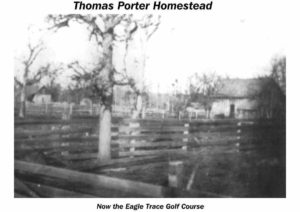
Thomas, Abigail, and Maude Porter provided a home across the street for friends and relatives in their large home once it was built in 1871. This large white structure is on your right close to Porter Circle. After Maude moved out in 1910, Frank Kothmann owned it and most of the land.
Finally, you’ll be pulling into Eagle Drive on the left. Here you’ll be entertained even more Friday and Saturday, Aug. 2-3. The Rendezvous will start Saturday and go though Sunday. All the specifics can be found at https://www.facebook.com/events/498211524260628/.
Back to Simon Stevens….without his foresight and adventurous spirit, he may not have come to Clearwater. But this beautiful landscape surrounded by water wouldn’t have been unfounded for long. Stevens may not have had a big name written in many history books like his brother, but he took on every job the town gave him, built a large farm, and had a strong family that carried on his name for years to come. 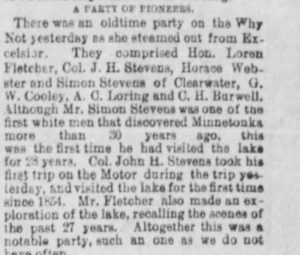
More information can be found in my Around Clearwater.
Thanks to Clearwater Remembers and Monticello Times for a couple of the various pictures provided.
On the road again
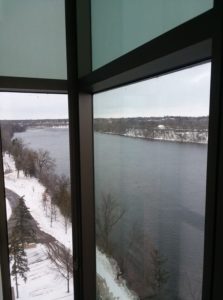
ON THE ROAD . . .
–TO RECOVERY–For those who didn’t know–
I finally had a knee replacement on May 3. Many of you saw me hobbling around. I’d have good days and bad days, but this winter was the worst. Not only had I needed this surgery for quite a while, but the knee had caused my ankle to degenerate from the reconstruction I had in 2005. This caused my podiatrist to have a brace designed and cast for me to wear to protect my ankle from further issues. My doctors, family, and I took special precautions in order to commit to my recovery–blood thinners due to a previous pulmonary embolism, intensive, in-house rehab physical therapy for 2 weeks 3 times a day, and when I was released to go home, lots of care and more physical therapy 3 times a week with my favorite PT. After 8 weeks of physical therapy, I’m doing great, and better yet, NO BOOT to protect the ankle.
–With REV. MARY MACNICHOLL-–
I am putting the final touches on the powerpoint slide presentation for the first woman to be fully ordained in the Minnesota Methodist Conference in 1958. Most of you know that I earned a grant from the United Methodist General Commission on Archives and History to write her story. Little did I know that this woman, Mary MacNicholl, who would be my minister in Clearwater, Minnesota, in the 1960s, had broken through her own ‘glass ceiling’. How did I know back then our church community would be served by such a celebrity? Not sure I or anyone else knew Mary Mac’s impact, but I know I felt honored to be noticed by her when I sang in the choir, attended Methodist Youth Fellowship, enrolled in our short confirmation class (Methodist youth usually have only a six-week education), she came to my graduation party, and when she often stopped to have coffee with my mom. She awoke our consciences, our awareness of the world around us, and our knowledge of our Methodist tradition. Sixty years after her ordination and forty years after her death, I hope to do justice to Mary MacNicholl’s story and service. The essay is ready to be sent to the United Methodist General Commission on Archives and History. The new and improved powerpoint will be tested when I speak at Wykoff United Methodist Church. This was one of the three churches Pastor Mary MacNicholl was charged with after she graduated from Drew Seminary in 1949. I will be presenting her story on July 21 during the church service at 8:30, a.m.
–BRINGING THE STORIES OF STRONG MINNESOTA MAIN STREET WOMEN TO MY READERS–
I was busy up to surgery–actually, less than a week before I sold my books at the St. Cloud River’s Edge Convention Center. Then the hiatus. Now, I am excited and ready to begin my busy time of the year–July through November.
After I present Mary MacNicholl’s story in Wykoff, I’ll be bringing my books, Minnesota Main Street Women series–Scruples & Drams and Pins & Needles, Around Clearwater, and Postcards from the Old Man to sell at the Clearwater Heritage Days at the Rendezvous at the dam, off Highway 75 and the north end of Main Street, Saturday and Sunday, August 3-4.
Come see me at the Clearwater dam where I’ll be participating in the Rendezvous. Here where the Clearwater River merges with the Mississippi, the village was first created. In the 1850s, sawmills lined the banks and built the first houses and store buildings. Feed mills, sawmills, stores of all kinds– hardware, general merchandise, jewelry, clothing, shoe, and furniture sat on the banks of the Clearwater or up on Oak Street and Main Streets. These buildings and the people who occupy them are the subjects of my Around Clearwater history and Minnesota Main Street Women series. Each protagonist, Jennie Phillips in Scruples & Drams and Maude Porter in Pins & Needles, a real woman pioneer from Clearwater, made her mark on the community. They both see gender inequalities in the world as far as suffrage, health, education, and legal issues. Their desire to make things right for the women and their families they encounter is a major theme in my series.
If you want to know history, Arcadia Publishing’s Image of America: Around Clearwater is the most up-to-date word on early Clearwater.” Burrowed below bluffs overlooking the Mississippi and Clearwater Rivers, Clearwater’s houses, its churches, and most of its original businesses resemble those that settlers had left behind in the East. With its arch-like trees sheltering Oak and Main Streets, the community remained home to many who lived and died there and those who had moved on only to return for yearly Old Settlers gatherings. This sense of community allowed Clearwater to thrive. Flour and pulp mills lined the shores of the Clearwater River. Mercantile, hardware, jewelry, and drug stores cropped up, providing the products for a growing community. Trade once powered by steamboats on the Mississippi was taken over by James Hills Great Northern Railroad. While the village and surroundings have changed over time, the original charm is still there, ready to be explored again.”
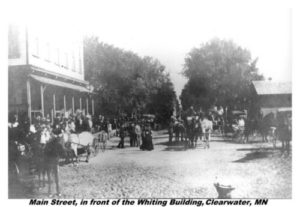
–WITH SOME FINAL THOUGHTS–
Speaking of Clearwater, Minnesota’s heritage that I have been writing about for a number of years, Clearwater’s Heritage Days is coming up August 2-3, with the Rendezvous lasting through Sunday. Along with coronation activities going on before the celebration begins, the parade comes back to downtown Clearwater on Friday night at 7:00 beginning at the Clearwater Dam. What a great move back to come back where the village began by the Clearwater and Mississippi Rivers. The parade route will begin there and end up at Eagle Trace Golf Course.
This length of Main Street will take you by many of the historic sites– past the Boutwell Hardware and Pat Quinn’s Saloon (neither are standing–that I write about in Maude Porter’s story, Pins & Needles. It will take you past the historic United Methodist Church I attended when I was in my youth, and down to the drug store (now an apartment building) I write about in Jennie Phillips’s, the woman druggist) story, Scruples & Drams. Three blocks further you will come to the Thomas Porter home and farm that he built beginning in the 1870s. He was a fur trader, farmer, village treasure and besides serving Wright County, and served in the Minnesota Legislature for a few terms. Your final stop will be at Eagle Trace Golf Club, which was his original land that extends down to the Mississippi River. I had trouble with the golf club’s webpage but this gives you at least the location: 1100 Main St. https://www.yelp.com/biz/eagle-trace-golf-and-event-center-clearwater
Come join us for some fun. I’ll keep up better from now on and let you in on the different spots I’ll be located over the next few months.
Cindy
P.S. Please “Subscribe” on my homepage.
Reverend Mary MacNicholl: A Woman with Vision
Unfortunately, this event has been postponed. We will be rescheduling soon.
Spring is here, unfortunately causing lots of water and damage. I sit on sandy soil so house and hubby are high and dry. Other people and places–less so. And I am taking a trip to southern Minnesota–where lots of snow and rain have made life uncomfortable for so many. Hopefully, this melt will slow down soon, floods will recede, and white, yellow, and lavender-blue wood-sorrel will sprout on the Midwest prairies.
As I said, I am heading south over the weekend of April 6-7. Many of you remember that I earned a grant from the United Methodist Church’s General Commission on Archives and History to research and write about the life of one of my minister’s, Reverend Mary MacNicholl. She served almost entirely in Minnesota from 1950-1971.
I’ve learned so much about this woman. As a child living in Merchantville, New Jersey, Mary MacNicholl felt an early call to become a minister, and told her kindergarten teacher her plans. We have no idea what her teacher might have thought or said to her; it was the early 1920’s, women just received the vote, and many became hopeful for their futures. Yet, if the woman tried to discourage her, Mary stood fast to her goals and let nothing dissuade her. Truth be told, Miss Mac seldom swerved on her path, even if she had to side-track around a few boulders to get where she needed to go.
I am bringing the story of Reverend Mary MacNicholl’s story back to one of the churches, the Wykoff United Methodist, where she first preached in Minnesota in the 1950’s and where she became the first ordained woman minister of the Methodist faith in 1958 in Minnesota The woman minister’s courage, strength, endurance, perseverance, and quality of character impressed many. Just as important, Reverend Mary MacNicholl, Miss Mac, Miss Mary, Mary Mac–paved a path for so many to follow.
If you are in the area, come and learn about this inspirational woman.
Wykoff United Methodist Church, Wykoff, Minnesota.
April 7 at 10 a.m.
I’ll be posting again soon. I have a big event in St. Cloud at the Convention Center the last weekend in April. More to come.
Cindy



